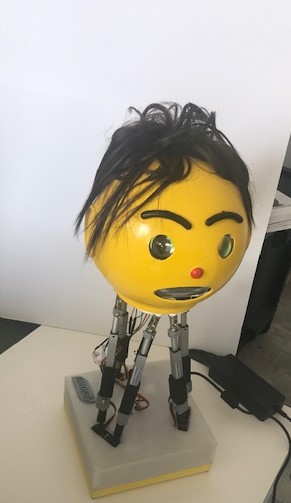Result description
The emotion-expressive robot EmoSan has six degrees of freedom and can reproduce the movements of the human head, e.g. it can achieve a rotation and translation of the head in order to simulate a bending of the neck. The design of the robot is based on the Gough-Stewart platform mechanism and the analysis of the robot motions reveals that the robot is capable of imitating the movements of the human head to a great extent. The EmoSan robot can perform motions programmed in advance or it can be controlled by an EMOTIV brain headset in real time. The captured human head motion is transferred to the EmoSan robot. Thus, the robot can follow the motion of the human head. The robot also has controllable eyes, eyebrows and mouth. We have developed scenarios involving EmoSan and NAO robots designed for improvement of the pedagogical rehabilitation of children with Special Educational Needs. These scenarios develop the child’s emotional knowledge and memory in play-like activities mediated by emotion-expressive social robots.
Addressing target audiences and expressing needs
- Grants and Subsidies
- Collaboration
We propose a novel social robot prototype for expressing certain basic emotions. We would like to join a project or receive a grant on further developemnt of social robotics.
- Public or private funding institutions
- Research and Technology Organisations
- Private Investors
R&D, Technology and Innovation aspects
The robots have been applied for therapy of children with communication disorders and proved feasible.
It is envisaged to further develop the smart behaviours of the EmoSan robot.
Replicability concerns the new design of the EmoSan robot. It is replicable.
The robot enhances the quality and efficiency of the delivered therapy by the professionals.
- Europe
Result submitted to Horizon Results Platform by INSTITUT PO ROBOTIKA

